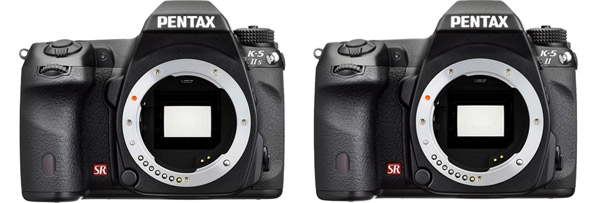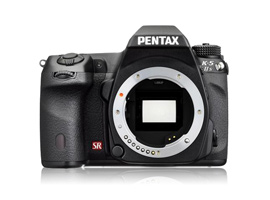Introduction

So why would you want a DSLR with the anti-aliasing filter removed? Well, the answer is simple. As the filter is applied to the whole image it also reduces sharpness in larger details where moiré wouldn’t appear, so with the filter gone greater overall detail can be resolved. Of benefit to photographers desiring superior resolution for highly detailed images and with the only other DSLR without an anti-aliasing filter currently available being the Nikon D800E, Pentax obviously sees an opportunity to exploit this area of the market with the K-5 IIs.

K-5 IIs ranks as high as the K-5 II


With the same DxOMark Overall Score of 82 as the K-5 II removing the anti-aliasing filter hasn’t negatively impacted image quality on the K-5 IIs. The K-5 IIs maintains the excellent results of the K-5 II keeping it in an amazing 12th position overall, only behind professional full-frame and medium format cameras from Nikon, Sony and Phase One. The K-5 IIs achieves the same DxOMark Overall Score as Pentax 645D medium format and Nikon D3s professional cameras and is well ahead of its semi-pro rivals, like the Canon 7D, Nikon D7000, and Sony A77.
Digging a little deeper the K-5 IIs Portrait Score (Color Depth) of 23.9 bits places it 20th overall, just fractionally better than the K-5 II, and the leading camera in the semi-pro range.
Excellence continues in the Landscape Score too, with the K-5 IIs achieving a stunning 14.1Evs of Dynamic Range that places it 4th out of all cameras and is only outdone by the Nikon D800, D800E and Sony A99.
The Sports Score (Low-Light ISO) of 1208 ISO on the K-5 IIs is equal to that of the K-5 II, but in this aspect the camera doesn’t live up to the high standards set in the Portrait & Landscape Scores, which has impacted on its DxOMark Overall Score of 82.
Pentax K-5 IIs vs Nikon D800E: Anti-aliasing free DSLRs go head to head
As the DxOMark Camera Sensor Ratings for the K-5 IIs are so similar to the K-5 II already reviewed (where we compared scores to its semi-pro market rivals) for this K-5 IIs review comparisons with professional cameras adds more perspective.
The obvious comparison is to the only other DSLR without an anti-aliasing filter, the £2390 36Mpix full-frame Nikon D800E, costing around £1450 more than the 16Mpix Pentax K-5 IIs with its APS-C sensor.
DxOMark Sensor Measurements indicate the pixel quality of these two cameras is very similar, illustrated by the results recorded in Screen Mode. Differences in image quality are more pronounced however when examining DxOMark Measurements in Print Mode due to the larger full-frame sensor utilized by the D800E.


Drilling down into the Landscape Score (Dynamic Range) at base ISO sensitivities the scores are also very similar, 14.33 Ev for the D800E and 14.14 Ev for the K-5 IIs. For landscape work at the base sensitivity the K-5 IIs is virtually as good as the D800E in terms of Dynamic Range. It’s only as you increase ISO sensitivity where the D800E pulls ahead and at the Measured ISO1600 result the difference is at its most pronounced with the D800E displaying around a ½ stop improvement over the K-5 IIs. Remember this only considers Dynamic Range however and doesn’t take account of the advantages the greater resolution and full-frame sensor of the D800E offers for landscape photography.

Looking at Color Sensitivity the same pattern doesn’t continue however where the D800E out performs the K-5 IIs at all ISO sensitivities and records rich color with the sensor sensitivity set roughly 1-stop higher than the K-5 IIs. This remains true up to ISO 3200 where the difference narrows due to the Pentax high ISO ‘smoothing’ that reduces noise in all images including RAW files. In-camera ‘smoothing’ (even of RAW files) reduces image sharpness however and can lead to the complete loss of fine detail (For further information on Pentax high ISO noise smoothing, see our DxOMark review for Pentax cameras). Regardless this image processing for studio or portrait photographers the D800E renders better Color Depth for richer and more nuanced color.

The most pronounced difference appears when we look at the SNR18% chart and the Sports (Low-Light ISO) ratings. The D800E hits 2-stops better low-light performance than the K-5 IIs recording pictures without significant quality loss at ISO 3200, the K-5 IIs only manages this up to ISO 800. Despite the fact pixel quality between the two cameras is very similar the larger full frame sensor of the D800E catches more light and, as a result, less noise. The significantly higher resolution of the D800E, 36Mpix compared to the K5 IIs 16Mpix, also in theory results in sharper resolution from the D800E.

Pentax K-5 IIs vs Nikon D600 vs Canon EOS 5D Mark III: The K-5 IIs takes on two ‘affordable’ full-frame DSLRs
So the K-5 IIs doesn’t quite live up to the benchmarks set by the D800E but how does it fare against other notable full-frame models like the Nikon D600 and Canon 5D MKIII that although often classed as ‘affordable’ still cost significantly more than the K-5 IIs? Well with an overall score of 94 the 24Mpix Nikon D600 remains well out in front achieving the best results in all categories and with the highest resolution of the three models to boot. The K-5 IIs does nudge the 5D MKIII into 3rd however with an overall score of 82 compared to 81.
Examining the Portrait (Colour Depth) ratings more closely indicates little difference between the K-5 IIs and 5D MKIII with 23.9 bits compared to 24 bits respectively. So it’s left to the Landscape and Sports categories for the pros and cons of these models to become apparent. Significantly trumping the 5D MKIII with a Landscape rating of 14.1 Ev the K-5 IIs records a massive 2.4 Ev greater Dynamic Range than the Canon and it’s worth repeating that rating puts it a 4th out of all cameras for Dynamic Range.
If low-light performance is more important though the full-frame 5D MKIII’s Sports Score of 2293 ISO compared to 1208 ISO on the K-5 IIs gives it the edge. In real terms it means the 5D MKII captures acceptable pictures with the sensor set roughly 1-stop more sensitive than the K-5 IIs can be and as a result the Canon lends itself better to the often low-light environments of press or wedding work.

Overall therefore the D600 is way out in front but its horses for courses choosing between the K-5 IIs and the 5D MKII depending on what you’re going to shoot. With a very similar DxOMark Overall Score between the two but a better Low-light ISO rating the 5D MKIII is the more versatile camera but it can’t get anywhere close to the dizzying heights the K-5 IIs sets for Dynamic Range.
Removing the anti-aliasing filter for greater definition on the Pentax K-5 IIs hasn’t had a negative impact on its DxOMark Camera Sensor Ratings. It’s an exceptional camera that’s top of its class for semi-pro models and holds its own against many expensive pro models, too. It can’t compete with the latest evolution of Nikon full-frame models, like the D600, D800 & D800E or the Sony A99. Where it does fall down however is in the Sports category with Low-Light ISO ratings that don’t come close to professional sports cameras or the full-frame models of the Nikon D600, D800 or D800E. If it’s a studio or landscape camera you’re after however, you’re happy to shoot at low ISO sensitivities and you can avoid the danger of moiré the Pentax K-5 IIs is phenomenal and sets the bench mark for semi-pro DSLRs in the DxOMark Camera Sensor Ratings.






DXOMARK encourages its readers to share comments on the articles. To read or post comments, Disqus cookies are required. Change your Cookies Preferences and read more about our Comment Policy.